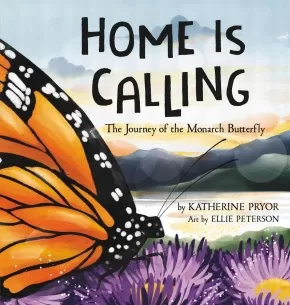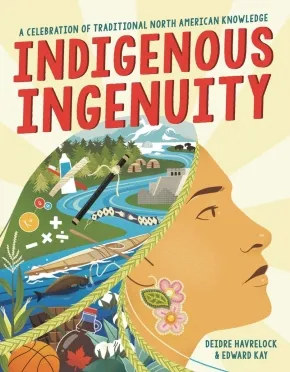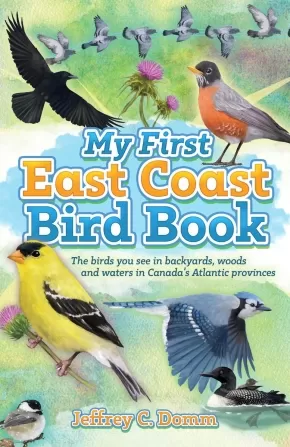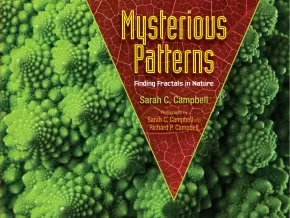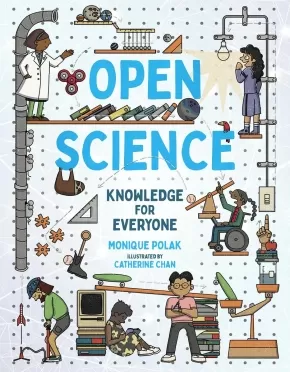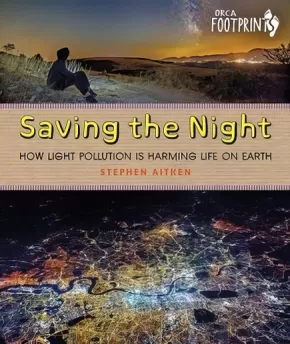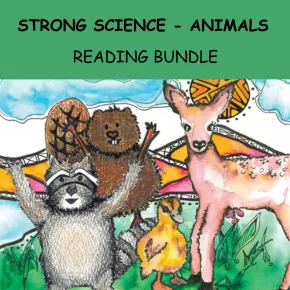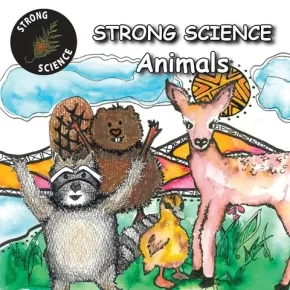
Science and Technology
46
-
60
of
428 Results;
Sort By
Go To
of 29
Home Is Calling: The Journey of the Monarch Butterfly
$22.99
Artists:
Format:
Hardcover
ISBN / Barcode: 9781546003137
Synopsis:
Synopsis:
Join the monarchs as they embark on a transcontinental journey home in this moving story about migration.
As the sun dawns in Canada, a flutter of monarch butterflies take flight, ready to begin their months-long journey to their ancestral home in Mexico. The migration will not be easy, but it is necessary for the next generation of monarchs to be born. Brought to life with illustrations as vivid as the monarch’s iconic orange and black hues, this story invites young readers to experience the monarch’s migration from the butterflies’ point of view as they search for food, huddle together through storms, and tirelessly fly south.
Parents and educators alike will find much to love about this poetically written book. The story touches on how climate change and deforestation are impacting monarchs, and kid-friendly back matter provides additional information about the butterflies, including their life cycle, anatomy, and migratory patterns, as well as several simple ways children can help monarch butterflies themselves.
Educator Information
Recommended for ages 4 to 7.
Additional information
40 pages | 9.50" x 10.00" | Hardcover
Indigenous Ingenuity: A Celebration of Traditional North American Knowledge (PB)
$12.99
Artists:
Format:
Paperback
ISBN / Barcode: 9780316413435
Synopsis:
Synopsis:
Celebrate Indigenous thinkers and inventions with this beautifully designed, award-winning interactive nonfiction book—perfect for fans of Braiding Sweetgrass.
Corn. Chocolate. Fishing hooks. Boats that float. Insulated double-walled construction. Recorded history and folklore. Life-saving disinfectant. Forest fire management. Our lives would be unrecognizable without these, and countless other, scientific discoveries and technological inventions from Indigenous North Americans.
Spanning topics from transportation to civil engineering, hunting technologies, astronomy, brain surgery, architecture, and agriculture, Indigenous Ingenuity is a wide-ranging STEM offering that answers the call for Indigenous nonfiction by reappropriating hidden history. The book includes fun, simple activities and experiments that kids can do to better understand and enjoy the principles used by Indigenous inventors. Readers of all ages are invited to celebrate traditional North American Indigenous innovation, and to embrace the mindset of reciprocity, environmental responsibility, and the interconnectedness of all life.
Reviews
"An astonishing, exuberant treasure trove of history, science and hands-on activities that repeatedly begs the question: "Why didn't I know this?" Essential for kids and adults. We need this book." —Candace Fleming, award-winning author of The Rise and Fall of Charles Lindbergh and The Family Romanov
"This book will amaze readers and teachers as it demonstrates how pervasive and critical the history of Indigenous people is. A completely unique and important narrative not to be missed; readers and teachers will come away with a new appreciation for the myriad contributions Indigenous people have made."—SLJ, starred review
"A conversational tone invites readers to engage with this monumental collection . . . Curious readers will learn facts unique to individual tribal groups while gaining knowledge of STEM/STEAM concepts. An ambitious, appealing, and accessible work documenting and protecting valuable knowledge."—Kirkus Reviews
"Engaging and informative, this will be welcomed by both STEM and social studies curricula to help to correct prevailing narratives about Indigenous technology."—Booklist, starred review
"Via authoritative, meticulously researched prose, the creators detail Native peoples’ significant strides in scientific pursuits . . . [and] showcase Native tribes’ continual and enduring impact. Photographs, as well as interactive activities detailing recipes and science experiments, feature throughout, lending a hands-on approach to this clear and concise work."—Publishers Weekly
"This book is a valuable contribution to efforts to decolonize learning and introduce readers to the breadth of indigenous knowledge as practiced in widely disparate geographic zones."—Canadian Review of Materials
"An engaging and cleverly compiled guide to North American and Mesoamerican Indigenous innovation. STEM topics (housing, medicine, clothing, agriculture, and hunting among them) are compellingly and conversationally discussed."—Shelf Awareness
Educator Information
Recommended for ages 8 to 12.
Fountas & Pinnell Text Level Gradient: Z
Additional Information
288 pages | 6.95" x 9.00" | Paperback
Less Is More: Join the Low-Waste Movement
$21.95
Format:
Hardcover
ISBN / Barcode: 9781459835443
Synopsis:
Synopsis:
All over the world, people are joining the low-waste movement and getting tough on their trash.
Maybe you’ve heard the reports of the Great Pacific Garbage Patch swirling in the ocean. Maybe you’ve seen the photos of whales and sea birds with trash in their bellies. Or maybe you’ve heard that only 9 percent of our plastic waste actually gets recycled.
We can all do our part for the planet by creating less garbage. In Less Is More young readers will discover how to avoid waste in the first place, reduce how much they use and reuse what they can, before they recycle and rot (compost) the rest. With small, simple actions we can become part of the circular economy. Find out how you can join the low-waste movement—and get your friends and family on board too!
Educator & Series Information
Recommended for ages 9 to 12.
This book is part of the Orca Footprint series.
Additional Information
48 pages | 8.00" x 9.50" | 51 Colour Photos, 3 Colour Tables, 2 Diagrams, 1 Index, 1 Bibliography | Hardcover
My First East Coast Bird Book: The Birds You See in Back Yards, Woods, and Waters in Canada's Atlantic Provinces
$19.95
Artists:
Format:
Paperback
ISBN / Barcode: 9781459507128
Synopsis:
Synopsis:
An all-new, richly illustrated easy-to-use guide that with the six identifying features of each of the most common birds on the east coast.
This book makes identifying the most common birds found on the east coast of Canada easy. It includes detailed illustrations of every bird, showcasing their size and colour, flight patterns, dietary habits and other useful facts.
Using this book, kids and novice bird watchers will be able to identify birds you may see in your back yard, on the trails or at the beach, helping them to reconnect with nature and wildlife.
Author and illustrator Jeffrey C. Domm is an expert with over 20 nature guides published. His illustrations go far beyond anything seen in common bird guides with detail and clarity.
More than forty birds are included, from those you will see in your backyard – like the American crow and the Blue Jay – to those you will see while at the beach or walking along a trail, like the Great Blue Heron and the Bald Eagle. Each bird has over ten illustrations for easy and clear identification.
Reviews
"This book is charming...looking closer at the book I noticed the bird images weren’t the generated images I thought they were. They were illustrations. And beautiful ones." — Katy Jean, The Chronicle Herald
Educator Information
Children's Book.
Additional Information
104 pages | 5.51" x 8.50" | Paperback
Mysterious Patterns: Finding Fractals in Nature
$13.99
Artists:
Format:
Paperback
ISBN / Barcode: 9781662620416
Synopsis:
Synopsis:
Nature's repeating patterns, better known as fractals, are beautiful, universal, and explain much about how things grow. Fractals can also be quantified mathematically. Here is an elegant introduction to fractals through examples that can be seen in parks, rivers, and our very own backyards.
Young readers will be fascinated to learn that broccoli florets are fractals—just like mountain ranges, river systems, and trees—and will share in the wonder of math as it is reflected in the world around us. Perfect for any elementary school classroom or library, Mysterious Patterns is an exciting interdisciplinary introduction to repeating patterns.
Reviews
"This fascinating exploration should awaken readers' powers of observation and appreciation for the intricacies of nature." —Publishers Weekly, starred review
"Using clear text and outstanding color photographs, Campbell explores the concept of these unusual shapes. . . An afterword reveals more of Mandlebrot's background and work, which will be an inspiration to budding scientists/mathematicians." —School Library Journal, starred review
"This beautifully designed volume is a useful resource and, apparently, the only children's book devoted to fractals." —Booklist
"Through examples of what fractals are and what they aren't, this photo essay introduces a complex mathematical idea in a simple, inviting way. Using a straightforward text and eye-catching photographs, the Campbells start with the familiar: spheres, cones, cylinders--shapes readers can find and readily name in their environments. But then they move on to the more elaborate forms . . . For visual learners, this is a particularly accessible demonstration of an intriguing concept." —Kirkus Reviews
Educator Information
Recommended for grades 2 to 5.
Additional Information
32 pages | 11.06" x 8.50" | Paperback | Full-Colour Photographs
Open Science: Knowledge for Everyone
$26.95
Artists:
Format:
Hardcover
ISBN / Barcode: 9781459833586
Synopsis:
Synopsis:
Science is for everyone, right?
Unfortunately, that's not always true. Discovery, research and innovation are often top secret, and big businesses charge high prices for that information. The field of open science is trying to change that. It's all about sharing knowledge. Teams of scientists around the world are working together to improve and speed up scientific research and share their results so that everyone benefits.
Open Science: Knowledge for Everyone examines the history of scientific research and how ideas and information are shared and why. It also looks at innovations made using open science, such as treatments for diseases and vaccines to protect against viruses like COVID-19, discoveries that were only possible thanks to the sharing of information. Discover how regular people, including kids, can be citizen scientists and what we all can do to share science and make the world a better place.
Reviews
“Highlights the benefits of researchers working together to find solutions and sharing them in a variety of contexts…Colourful illustrations throughout are particularly effective in underscoring the importance of emphasizing equity, diversity, and inclusivity in science. Inspiring and informative for readers interested in ensuring that scientific research is more accessible to everyone.” — Booklist
Educator & Series Information
Recommended for ages 9 to 12.
This book is part of the Orca Think series.
Additional Information
96 pages | 7.00" x 9.00" | 30 Colour Illustrations, 8 b&w Photos, 69 Colour Photos, 1 Index, 1 Bibliography | Hardcover
Saving the Night: How Light Pollution Is Harming Life on Earth
$21.95
Format:
Hardcover
ISBN / Barcode: 9781459831070
Synopsis:
Synopsis:
Light pollution threatens the survival of every living species on our planet, including people.
It started when Thomas Edison invented the first light bulb more than 150 years ago. Then, as electric light became more common, light pollution began to take over cities and towns. Today, in urban centers all over the world, the stars in the sky aren't visible. Millions of people have never seen the Milky Way. In Saving the Night, we discover how plants and animals have adapted over millions of years to survive and thrive in the dark, and how artificial light can upset the balance of entire ecosystems. But there are ways we can take back the night for animals, plants and us. It starts with the flick of a switch.
Reviews
“Richly described and alluring…Aitken urges his readers to be unafraid of the dark and after reading this excellent book, tweens will want to venture forth into the night without a flashlight.”— School Library Journal
“Both personal and poetic…A very comprehensive look at the role of light in the natural world and the effect of light pollution on all living organisms. This book deserves to be available and promoted in schools and libraries. Saving the night for all of us is worth it. Highly Recommended.” — CM: Canadian Review of Materials
“[An] informative addition to the Footprints series…This organized, involving book will fill a gap in many library collections.”— Booklist
“Flashes on a too often unconsidered sort of environmental pollution.”— Kirkus Reviews
Educator & Series Information
This book is part of the Orca Footprint series. Kids today inhabit a world full of complex—and often mystifying—environmental issues. Orca Footprints aim to help kids answer their questions about the state of the natural world with well-researched, simply-expressed information and powerful images. With topics such as food production, water, cycling and sustainable energy, these books will inspire kids to take action.
Recommended for ages 9-12.
Additional Information
48 pages | 8.00" x 9.50" | Hardcover
Seagull Island: kiyāsko-miniscikos
$22.95
Artists:
Format:
Hardcover
Text Content Territories:
Indigenous Canadian; First Nations; Cree (Nehiyawak); Woodland Cree;
ISBN / Barcode: 9781778690105
Synopsis:
Synopsis:
“waniskā. wāpan,” mosōm says. “Wake up. It’s morning, little one. You, me, and kohkom are going for a boat ride for the day.”
And that is exactly what they do in this quiet book that celebrates traditional life in modern times. Held warmly in his kohkom’s arms, little Luke watches ducks, pelicans and cormorants on the way to Seagull Island, where the family collects eggs for their shore lunch and to share later with Auntie at home.
Seagull Island: kiyāsko-miniscikos is inspired by Elder Myles Hector Charles’s memories of gathering eggs with his grandson Luke in northern Saskatchewan.
Written in English with Woodland Cree words and phrases, the story and illustrations show the deep connection between families and the land.
Educator Information
Recommended for ages 5 to 10.
Written in English with Woodland Cree words and phrases.
Additional Information
24 pages | 9.00" x 9.00" | Hardcover
Strong Science - Animals Reading Bundle
$648.00 $720.00
Text Content Territories:
Indigenous Canadian;
Grade Levels: Kindergarten; 1;
ISBN / Barcode: 9781771746267
Synopsis:
Synopsis:
This bundle includes six copies of each of the 16 titles in the Strong Science - Animals series (96 books total).
Series Information
Strong Science - Animals is a language-based science series for primary students featuring animals that all Canadian students will recognize. Photographs and Indigenous artwork illustrate the series. Common learning objectives in science curricula across Canada are addressed, and suggestions for extending the learning to other curriculum areas, including Indigenous cultural awareness, language arts, math, and art, are included in the teacher’s guide. The sixteen books in this series are grouped into four levels that increase in complexity, designed to accommodate students with various reading abilities within a classroom. This feature facilitates the use of this series in literacy programs along with the Strong Readers series.
This series works best as a unit with the teacher's guide: Strong Science - Animals Teacher's Guide. The series is recommended for use in a grade 1 classroom, but may also be useful for kindergarten students.
Books in this series are divided into four levels: Early Primary 1 (EP1); Early Primary 2 (EP2); Early Primary 3 (EP3); Early Primary 4 (EP4). Font size decreases as language complexity and word count increase across levels: EP1 books have approximately 40 words, EP2 books have approximately 60 words, EP3 books have approximately 80 words, and EP4 books have approximately 100 words.
Authenticity Note: In the series, titles by author Kim Soo Goodtrack have received the Indigenous Text label because she is Indigenous (Lakota) and the featured animal in each story holds cultural significance in many Indigenous cultures. The engaging stories provide factual information in an easy-to-read format for children to learn science concepts and build literacy skills. They promote respect for animals and Mother Earth, and their illustrations communicate additional cultural information through Lakota symbolism and designs. Further cultural connections are identified in the teacher's guide. Refer to the guide to explore the books' Indigenous connections fully.
Series Authors: Brenda Boreham and Kim Soo Goodtrack
Series Illustrator: Kim Soo Goodtrack
Additional Information
Each book is 16 Pages | Each book is 6.5" x 5.5" | Paperback | ISBN: 9781771746267
Strong Science - Animals Single Set Bundle
 $108.00 $120.00
$108.00 $120.00

Text Content Territories:
Indigenous Canadian;
Grade Levels: Kindergarten; 1;
ISBN / Barcode: 9781771746250
Synopsis:
Synopsis:
This bundle includes one copy of each of the 16 titles in the Strong Science - Animals series (16 books total).
Series Information
Strong Science - Animals is a language-based science series for primary students featuring animals that all Canadian students will recognize. Photographs and Indigenous artwork illustrate the series. Common learning objectives in science curricula across Canada are addressed, and suggestions for extending the learning to other curriculum areas, including Indigenous cultural awareness, language arts, math, and art, are included in the teacher’s guide. The sixteen books in this series are grouped into four levels that increase in complexity, designed to accommodate students with various reading abilities within a classroom. This feature facilitates the use of this series in literacy programs along with the Strong Readers series.
This series works best as a unit with the teacher's guide: Strong Science - Animals Teacher's Guide. The series is recommended for use in a grade 1 classroom, but may also be useful for kindergarten students.
Books in this series are divided into four levels: Early Primary 1 (EP1); Early Primary 2 (EP2); Early Primary 3 (EP3); Early Primary 4 (EP4). Font size decreases as language complexity and word count increase across levels: EP1 books have approximately 40 words, EP2 books have approximately 60 words, EP3 books have approximately 80 words, and EP4 books have approximately 100 words.
Authenticity Note: In the series, titles by author Kim Soo Goodtrack have received the Indigenous Text label because she is Indigenous (Lakota) and the featured animal in each story holds cultural significance in many Indigenous cultures. The engaging stories provide factual information in an easy-to-read format for children to learn science concepts and build literacy skills. They promote respect for animals and Mother Earth, and their illustrations communicate additional cultural information through Lakota symbolism and designs. Further cultural connections are identified in the teacher's guide. Refer to the guide to explore the books' Indigenous connections fully.
Series Authors: Brenda Boreham and Kim Soo Goodtrack
Series Illustrator: Kim Soo Goodtrack
Additional Information
Each book is 16 Pages | Each book is 6.5" x 5.5" | Paperback | ISBN 9781771746250
Strong Science - Animals Teacher's Guide
 $30.00
$30.00

Artists:
Format:
Coil Bound
Text Content Territories:
Indigenous Canadian; First Nations; Sioux; Lakota; Hunkpapa;
Grade Levels: 1;
ISBN / Barcode: 9781771746274
Synopsis:
Synopsis:
This teacher’s guide supports a language-based Science unit for early primary classrooms, using the sixteen titles in Strong Nations Publishing’s Strong Science - Animals series.
The unit introduces early primary students to four easily recognizable animals that live in or near many communities in Canada: beaver, black-tailed deer, mallard duck, and raccoon. While learning about the animals, students will gain knowledge and skills mandated by Ministry of Education Science curricula in Canadian provinces and territories.
In addition, this teacher’s guide addresses other curriculum areas— Language Arts, Math, Social Studies, and Art—and provides information to help develop an appreciation for and understanding of Indigenous cultures.
This teacher-friendly, comprehensive teacher’s guide provides:
• lesson plans to introduce the books in the Strong Science - Animals series;
• lesson plans to address knowledge and skills common to Canadian Science curricula;
• activities to integrate the unit across the curriculum;
• activities to wrap up the unit;
• reproducible activity pages.
Educator Information
The Strong Science - Animals series and teacher's guide is recommended for use with grade one students, but it may also be useful in kindergarten classes.
Additional Information
170 Pages | 8.5" x 11" | Coil Bound
Strong Science - Animals: A Beaver Family
 $7.50
$7.50

Format:
Paperback
Grade Levels: Kindergarten; 1;
ISBN / Barcode: 9781771746069
Synopsis:
Synopsis:
This book is about a beaver family.
Beavers work together to make their homes and to find food.
Have you seen beavers working in a lake, pond, or marsh?
Educator & Series Information
Recommended for grade 1 students, but may also be useful in kindergarten classrooms.
Strong Science - Animals is a language-based science series for primary students featuring animals that all Canadian students will recognize. Photographs and Indigenous artwork illustrate the series. Common learning objectives in science curricula across Canada are addressed, and suggestions for extending the learning to other curriculum areas, including Indigenous cultural awareness, language arts, math, and art, are included in the teacher’s guide. The sixteen books in this series are grouped into four levels that increase in complexity, designed to accommodate students with various reading abilities within a classroom. This feature facilitates the use of this series in literacy programs along with the Strong Readers series.
A Beaver Family is an EP2 (Early Primary 2) book in the Strong Science - Animals series. Font size decreases as language complexity and word count increase across levels: EP1 books have approximately 40 words, EP2 books have approximately 60 words, EP3 books have approximately 80 words, and EP4 books have approximately 100 words.
A teacher's guide for Strong Science - Animals is available: Strong Science - Animals: Teacher's Guide
Additional Information
16 Pages | 6.5" x 5.5" | Paperback | ISBN: 9781771746069
Strong Science - Animals: A Deer Family
 $7.50
$7.50

Format:
Paperback
Grade Levels: Kindergarten; 1;
ISBN / Barcode: 9781771746076
Synopsis:
Synopsis:
This book is about a black-tailed deer family.
Black-tailed deer live at the edge of the forest.
Have you seen deer in a park, field, or forest?
Educator & Series Information
Recommended for grade 1 students, but may also be useful in kindergarten classrooms.
Strong Science - Animals is a language-based science series for primary students featuring animals that all Canadian students will recognize. Photographs and Indigenous artwork illustrate the series. Common learning objectives in science curricula across Canada are addressed, and suggestions for extending the learning to other curriculum areas, including Indigenous cultural awareness, language arts, math, and art, are included in the teacher’s guide. The sixteen books in this series are grouped into four levels that increase in complexity, designed to accommodate students with various reading abilities within a classroom. This feature facilitates the use of this series in literacy programs along with the Strong Readers series.
A Deer Family is an EP2 (Early Primary 2) book in the Strong Science - Animals series. Font size decreases as language complexity and word count increase across levels: EP1 books have approximately 40 words, EP2 books have approximately 60 words, EP3 books have approximately 80 words, and EP4 books have approximately 100 words.
A teacher's guide for Strong Science - Animals is available: Strong Science - Animals: Teacher's Guide
Additional Information
16 Pages | 6.5" x 5.5" | Paperback | ISBN: 9781771746076
Strong Science - Animals: A Duck Family
 $7.50
$7.50

Format:
Paperback
Grade Levels: Kindergarten; 1;
ISBN / Barcode: 9781771746106
Synopsis:
Synopsis:
This book is about a mallard duck family.
Mallards live near water.
Have you seen mallards in a marsh, pond, or lake?
Educator & Series Information
Recommended for grade 1 students, but may also be useful in kindergarten classrooms.
Strong Science - Animals is a language-based science series for primary students featuring animals that all Canadian students will recognize. Photographs and Indigenous artwork illustrate the series. Common learning objectives in science curricula across Canada are addressed, and suggestions for extending the learning to other curriculum areas, including Indigenous cultural awareness, language arts, math, and art, are included in the teacher’s guide. The sixteen books in this series are grouped into four levels that increase in complexity, designed to accommodate students with various reading abilities within a classroom. This feature facilitates the use of this series in literacy programs along with the Strong Readers series.
A Duck Family is an EP2 (Early Primary 2) book in the Strong Science - Animals series. Font size decreases as language complexity and word count increase across levels: EP1 books have approximately 40 words, EP2 books have approximately 60 words, EP3 books have approximately 80 words, and EP4 books have approximately 100 words.
A teacher's guide for Strong Science - Animals is available: Strong Science - Animals: Teacher's Guide
Additional Information
16 Pages | 6.5" x 5.5" | Paperback | ISBN: 9781771746106
Strong Science - Animals: A Home for the Beavers
 $7.50
$7.50

Artists:
Format:
Paperback
Text Content Territories:
Indigenous Canadian;
Grade Levels: Kindergarten; 1;
ISBN / Barcode: 9781771746120
Synopsis:
Synopsis:
This story is about a beaver home.
Beavers make homes out of sticks, rocks, and mud.
There are four seasons in the year: winter, spring, summer, and fall. Which season is this story about?
Educator & Series Information
Recommended for grade 1 students, but may also be useful in kindergarten classrooms.
Strong Science - Animals is a language-based science series for primary students featuring animals that all Canadian students will recognize. Photographs and Indigenous artwork illustrate the series. Common learning objectives in science curricula across Canada are addressed, and suggestions for extending the learning to other curriculum areas, including Indigenous cultural awareness, language arts, math, and art, are included in the teacher’s guide. The sixteen books in this series are grouped into four levels that increase in complexity, designed to accommodate students with various reading abilities within a classroom. This feature facilitates the use of this series in literacy programs along with the Strong Readers series.
A Home for the Beavers is an EP3 (Early Primary 3) book in the Strong Science - Animals series. Font size decreases as language complexity and word count increase across levels: EP1 books have approximately 40 words, EP2 books have approximately 60 words, EP3 books have approximately 80 words, and EP4 books have approximately 100 words.
A teacher's guide for Strong Science - Animals is available: Strong Science - Animals: Teacher's Guide
Authenticity Note: This book has received the Indigenous Text label because the author is Indigenous (Lakota) and the featured animal holds cultural significance in many Indigenous cultures. The engaging story provides factual information in an easy-to-read format for children to learn science concepts and build literacy skills. It promotes respect for animals and Mother Earth, and its illustrations communicate additional cultural information through Lakota symbolism and designs. Further cultural connections are identified in the teacher's guide. Refer to the guide to explore the book's Indigenous connections fully. It is up to readers to determine if the book will work as a stand-alone authentic Indigenous text for their purposes.
Additional Information
16 Pages | 6.5" x 5.5" | Paperback | ISBN: 9781771746120
Sort By
Go To
of 29

